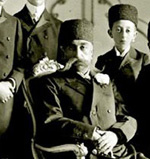The Iranian Ministry of Foreign Affairs

Motamenolmolk who had served in the field of Iranian foreign affairs initiated a rule book describing the structure of a Ministry of Foreign Affairs and presented it to the king in 1299 H.Q. (or .. AD). Having been approved by the king this rule book was to be the main reference in establishing the present day Iranian foreign office.
In the year 1300, after official approval of this rule book, the foreign office was put into effect as follows:
Minister, Chief Executive Officer for Foreign Affairs,
(This part was in effect equivalent to Assistant or Under Secretary of State for Foreign Affairs and at the onset was occupied by Mirza Mohammad Khan Sadiqolmolk Nuri, Hij Mohtashamol Soltaneh And Esfandiari's Father). There were also assistants to the undersecretary who served as consultants.
The following sub-sections or departments were also set up at the time.
- The Departmet for Correspondese and relay of Commands- 2 persons
- The Russian Desk – 6 Persons.
- The French, German, Austrian and American desk – 4 persons
- The Ottoman Desk – 5 persons
- The British Desk – 3 persons
- The Department for Protocols – 4 persons
- The Department of Records – 6 persons
Apart form the centrally located departments 70 additional personnel were assigned to the provinces and provisional towns were foreign citizens resided. These acted as liaisons who would oversee consular affairs. During this period, the Iranian foreign office established relations with a few countries. These were Germany in 1859, the Austrian-Hungarian Embassy in 1873. The British Government who established their embassy in 1800 AD that also dealt with affaires concerning the Dutch government.
The Italian embassy was established in the year 1886 AD and the Belgian Embassy in 1890. The U.S. embassy began work in Tehran in 1883.
In addition to the embassies in Tehran, some of these countries established consulates and vice-consulates in other Iranian cities.
British consulates were active in Mashahd, Tabriz, Rasht, Shiraz, Kermanshah, Isfahan, Hamedan & Astarabad.
The Russians established consulates in Mashahd, Tabriz, Astarabad, Rasht, Darjez and Kalat, Quchan, Bojnoord and Barforoosh.
The Ottoman Government had consulates in Tabirz, Kermanshah, Savejbolagh Makri (Mahabad) Hamedan, Shirz, and Bushehr. The French established consulates in Bushehr and Tabriz.
The first Iranian Consulates
During the same period, the Iranian government established consulates in the following cities and countries: Egypt, Qana, Beirut, Jiddah, Hakari, Taraboozan, Syria, Erzeroom, Bayazid, Alexandria, Izmir, Tantaneh, Halab, Baghdad, Basra, Holly Najaf, Khaneqain, Soleymaniyah, Kerkuk, Kazemain, Mandelish,
Diyar Bekr, Mosayeb, Omara Samavat, Holly Quds (Jerusalem,), Bakuba, Hilla, Ghezel Rabat, Entakiya, Bombay (Mumbai), Culcutta, Heydarabad, Dakin, Burma, Tbilisi, Irvan, Badhuba, Haji Tarkhan and Batum.
This book of procedural guidelines that was initiated and written by Mriza Saiid Khan stayed in effect until 1318 (Lunar Calendar) when Mirza Nasrollahkhan Moshirodolleh, the Foreign Minister of the period wrote and put into effect a second book of rules, procedures and guidelines.
This new administrative rules book was approved by Mozaffareddin Shah and established new procedures and a new structure for the Iranian Ministry of foreign affaires. The college of political science was established in 1317 to train future Iranian diplomats and foreign affaires experts. This school that was still active until 1927 AD operated under the Auspices and supervision of the Iranian Ministry for Foreign Affairs. In fact, this school was setup as one of the departments within the ministry. Most of Iran's senior diplomats and statesmen during the age of the constitutional revolution were graduates of this school.

